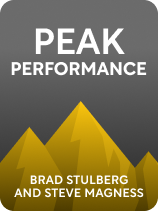

This article is an excerpt from the Shortform book guide to "Peak Performance" by Brad Stulberg and Steve Magness. Shortform has the world's best summaries and analyses of books you should be reading.
Like this article? Sign up for a free trial here.
What are ways to improve human performance? How can you convert growth into performance?
While utilizing a consistent cycle of stress and rest sets the foundation for performance, Brad Stulberg and Steve Magness acknowledge that growth alone doesn’t ensure elite performance. For this reason, they offer three additional steps for converting growth into performance.
Read on to learn how to improve your performance using a routine, pursuing your goals, and finding your purpose.
1. The Importance of Routine
According to Stulberg and Magness, an essential part of improving human performance in any domain is a consistent pre-performance routine. To craft your own routine, they recommend cultivating a positive mood, incorporating your environment into your routine, and personalizing your routine.
Make a Positive Mood Part of Your Routine
Stulberg and Magness contend that putting yourself in a positive mood is beneficial for both intellectual and athletic pursuits. Regarding intellectual work, they cite a study that assessed participants’ moods and then subjected the participants to creative problem-solving tests—participants whose moods were positive before the test consistently outperformed those whose moods were negative. Regarding athletic work, Stulberg and Magness point to a study of elite cyclists in which experimenters briefly flashed a happy or sad face to the cyclists during an intense workout; they found that those who saw the happy face performed significantly better than those who saw the sad face.
Stulberg and Magness suggest that there’s no foolproof path to putting yourself in a positive mood. However, they do recommend that you avoid things that you know will put you in a negative mood, since such factors will make it difficult for you to optimize your routine.
Incorporate Your Environment Into Your Routine
In addition to cultivating a positive mood, Stulberg and Magness advise intentionally creating an environment that’s conducive to success, since insights from ecological psychology show that our environment conditions our behavior. They point out, for instance, that merely seeing a photo of a chair stimulates the area of our brain associated with sitting in a chair. More generally, Stulberg and Magness contend that our brains can associate our working environments with high performance, priming us to succeed. For example, if a writer always writes in the same leather chair with a coffee on the desk, the very sight of that particular chair and coffee will prepare their brain for the act of writing.
Personalize Your Routine
Finally, Stulberg and Magness acknowledge that no two routines are identical, so you have to develop your own ideal routine. For instance, LeBron James is known for reading a book in the locker room before playoff games to calm his nerves, while Stephen Curry performs the same 20-minute on-court workout before every basketball game. So, according to Stulberg and Magness, as long as your routine involves a positive mood and an intentionally constructed environment, you’re free to craft the routine that suits you best.
2. The Importance of Intentionality
In addition to Stulberg and Magness’s recommendation that you intentionally structure your pre-performance routine, they also recommend that you intentionally structure your day-to-day life around your goals. Specifically, they offer the following concrete recommendations for intentionally pursuing your goals: Work in line with your chronotype; surround yourself with those who motivate you, and perform your best every single day.
Recommendation #1: Embrace Your Chronotype
First, Stulberg and Magness write that you should work in line with your chronotype to optimize your time. Your chronotype, they explain, is your body’s natural pattern of high and low energy throughout the day. For example, larks are most alert and energized in the morning, whereas owls are most energized at night. Consequently, the authors argue that for optimal performance, you should complete your most demanding work when your energy is highest—in the morning for larks, and in the evening for owls. But, because creative insights are most common when your energy is lower, as we previously saw, they note that you should instead perform creative tasks during your off-time—in the evening for larks, and morning for owls.
Recommendation #2: Find Encouraging Friends
While capitalizing on your chronotype can help you best structure your time, you might nonetheless work inefficiently if you’re surrounded by those who drag you down. In turn, Stulberg and Magness argue that you should surround yourself with friends who encourage and motivate you to strengthen your performance.
To defend this claim, they point to a study that investigated why some Air Force squadrons are significantly more fit after training than others, despite every squadron undergoing the same training. The determining factor, according to the study, was how motivated the least fit cadet was in a squadron; if the least fit cadet was highly motivated to improve, the whole squadron improved, and vice versa. Thus, the researchers concluded that motivation is contagious, as the least fit cadet either improved or diminished the other cadets’ motivation.
Recommendation #3: Consistently Perform Each Day
Finally, Stulberg and Magness write that to maximize your performance, you have to consistently perform each day rather than making excuses that impair your habits. They clarify that by sticking to your routine and performing every day, you’ll form habits that make it easier to perform in the future.
3. The Importance of Purpose
Having shown how an optimal routine and daily intentionality are conducive to top performance, Stulberg and Magness argue that one final factor is crucial for exceeding our limits: purpose. They contend that having a purpose that goes beyond our own interests is essential to maximizing performance, because such purposes help us overcome our perceived psychological limitations.
For context, Stulberg and Magness explain that physical fatigue lies not only in our bodies, but also in our minds. To show as much, they cite an experiment that asked weightlifters to perform leg exercises until physical exhaustion—the point at which they could no longer lift. Researchers then ran an electric current through their legs and found that their leg muscles could still contract, suggesting they weren’t truly depleted, even though the weightlifters believed they were.
Because fatigue lies partially in our minds, it stands to reason that if we could shift our perception of fatigue during stress, we could increase our performance. And, Stulberg and Magness report, one study suggests we can do just that. In this study, researchers scanned the brains of participants who were exposed to threats, asking one group to think about their core values beforehand. Those who thought about their values displayed brain activity showing that they perceived the threats positively. In other words, reflecting on their values allowed them to shift the brain’s perception of threats.
For this reason, Stulberg and Magness note that individuals with stronger senses of purpose performed better at their jobs. For example, one study of hospital janitors found that janitors who believed their job was crucial for helping patients heal performed better and were more satisfied than those who lacked this sense of purpose. Further, in a separate meta-analysis of over 200,000 employees, scientists found a significant positive association between increased job performance and employees’ belief that their job positively impacted others.
How to Find Your Purpose
Having highlighted the importance of purpose, Stulberg and Magness explain that you can find your purpose by identifying your core values and distilling them into a purpose statement.
Your core values, Stulberg and Magness explain, are values that are most central to your identity. To outline your core values, they recommend reflecting on the five values that are most important to you—for example, you might decide that education, relationship, spirituality, positivity, and loyalty are essential to who you are as a person. Afterward, they advise you to write a sentence or two about each of these values and rank them in terms of importance. For instance, you might conclude that deep relationship is your defining value and write “I hope to deepen my understanding of and empathy for people by cultivating vulnerable, lasting relationships.”
Stulberg and Magness write that the final step after writing these sentences is incorporating them into a coherent purpose statement—a declaration of your perceived purpose that reflects the values you previously selected. Because this process is so individualized, Stulberg and Magness provide no concrete tips for crafting your own purpose statement. However, a sample purpose statement for the previous set of values might look like this for a teacher: My purpose is to form lasting relationships with my students so that the process of education can extend beyond the mind and into the heart.

———End of Preview———
Like what you just read? Read the rest of the world's best book summary and analysis of Brad Stulberg and Steve Magness's "Peak Performance" at Shortform.
Here's what you'll find in our full Peak Performance summary:
- That the quest for excellence leaves us suffering from exhaustion and burnout
- Why cycles of stress and rest are necessary for sustainable elite performance
- How to develop a consistent routine and structure your time






